Ever been to a place that makes you say "wow" out loud several times a day? That's exactly what you'll do while trekking amidst the grand rice terraces of Sapa.
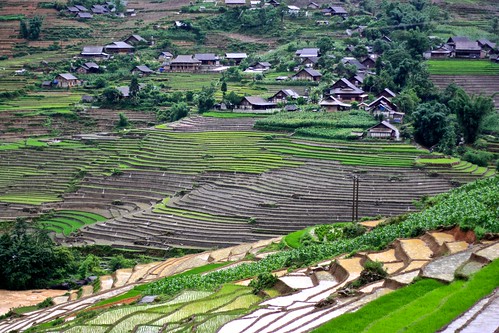
Ignore the naysayers: Sapa isn't overrated, it isn't overrun by tourists, and it isn't comparable to anywhere else in the country. This is one destination that's an absolute MUST on any Vietnam itinerary.
See and Do
You'll see the pictures of rice terraces in every single hotel and travel agency in Hanoi and you'll say, "There's no way it can look like that."

We're here to tell you that it can, and it does, but even better. We imagined one or two carved up valleys, but what we received was endless mountains of rice terraces, seemingly heading from the ground all the way into the clouds. You can walk for days without losing sight of the work—past and present—of the Black Hmong tribespeople. Around 2000 years ago, these hardy mountain inhabitants started shaping the local mountains into the terraces that would make Sapa famous, and that would help them grow enough rice to feed their families.
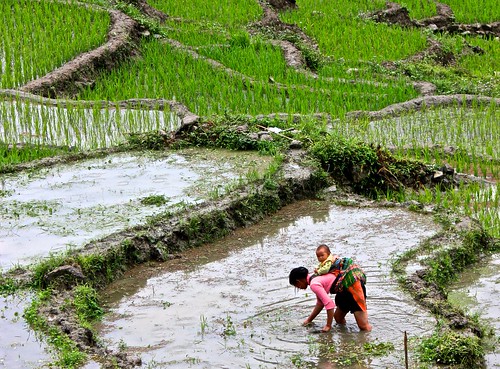
Nowadays, that's still what they do, though they've now added selling handmade trinkets to the tourists and speaking nearly perfect English to their repertoire. The terraces you see as you trek around the mountains are all owned by local families and the rice they produce isn't exported further than one family's house. Anything extra one family produces they share with their relatives, or trade for vegetables and fruit that they lack. Or perhaps a bit of tobacco.
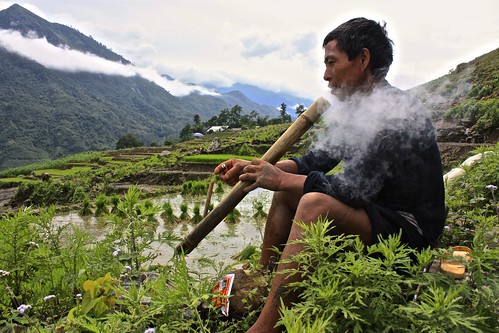
Your guide will most certainly be a young Hmong girl, dressed in traditional clothes, likely carrying a cell phone, and with working knowledge of English slang. Your "porters," at least on the first day, will be a gaggle of Hmong women, who will help you down the hills, offer to carry your bags, and show you how they make their indigo-dyed clothes. Around lunchtime, these ladies will turn into hardcore salespeople, who push their bags, headbands, and bracelets with an unrelentlessness that would make them fine salespeople in any Western country.

TIP: Keep you cool with the Hmong
It's hard to fathom, but selling one small bag a day makes them enough money to make the 10km walk by your side worth it. If you don't want to buy something, just walk into the restaurant, where they're not allowed.
So now that I've convinced you this is a place that needs to be the seen, the question is how best to see it. The options start right in Hanoi, where you can book Sapa trips to your heart's content. Most travelers do just that, picking an itinerary that typically involves either one night in a homestay, or one night in a hotel, followed by a night in a homestay.
The latter seemed silly, so we asked the awesome Lily of Lily's Travel Agency 18 Ngo Huyen, Hanoi about the "difficult" trek, which entailed about 45km of hiking through rice paddies and two nights at local people's houses. For about $10 more than the 1 night in hotel option, we got our wish.
We paid $72 each for the night bus to Sapa, all meals and accommodation in Sapa for three days and two nights, and a private guide. (We didn't need the bus back because we were heading to another area in the North following our trek.)
TIP: Several travelers paid double what we did
Make sure you shop around for the best price, and don't let the agents push you into booking the train. The bus is just fine.
We started our trek less than two hours after getting off the night bus, so the first morning was dicey. It was misting, which made the trails muddy and slippery, and I was a bit of a pathetic mess. The 80-year-old Hmong woman following us became both my guide and my crutch, helping me up and down the hills, while carrying a basket of goods on her back. Accompanying her were other Hmong women, two with babies on their backs that were completely silent the three hours we walked alongside them.
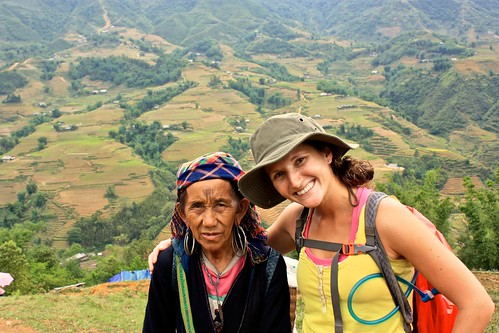
TIP: Be prepared for all weather
We highly recommend real hiking boots, a spare poncho, and clothes you don't mind getting dirty. During our trek, we had both hot and cold temperatures, monsoon-like rains, and mud that reached close to our knees.
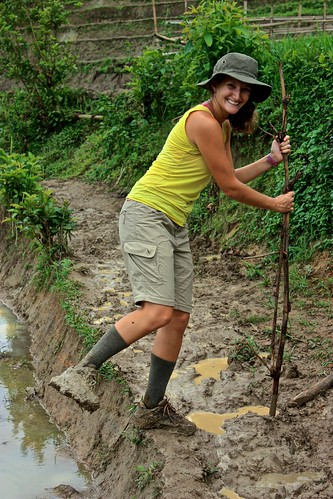
There's not much more I can say about Sapa besides the fact that it's absolutely gorgeous and you have to do it. Rob's photos of our Sapa trek don't even do it justice because we didn't have a lens wide enough to take in the vastness of these valleys.
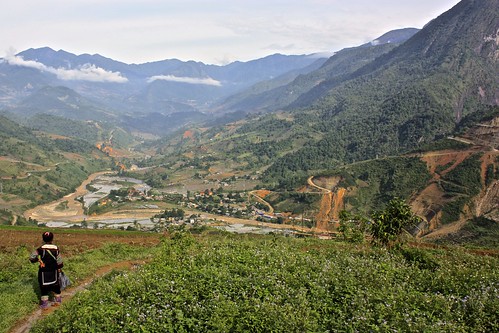
TIP: Do the two-night homestay trek
The scenery gets even better the second day, and you don't have to backtrack back to town.
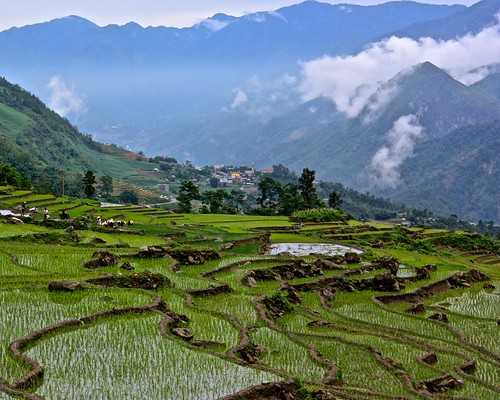
After the actual trek, our favorite part of the experience was the motorbike journey back to Sapa. For about 30km, we each sat on the back of a motorbike and had a chance to survey from up top the rice paddies through which we'd trod. The views were so incredible that we, again, couldn't capture them in photos.
TIP: Make sure motorbikes are included in your tour
A bus back to Sapa just wouldn't be the same.
If you don't book the trek in Hanoi, it's easy enough to do in Sapa itself. Hmong guides meet each bus and are more than happy to have customers that didn't pay commission to an agent or hotel. $10/day is a fair (and generous) rate for a guide, and they can set up your homestays and food as you go along.
The other option in Sapa is to trek up Mt. Fansipan, which is the highest peak in Vietnam. We met several travelers who did this, though most said the views at the top were diminished because of the fog. I'm always one for hiking up a mountain, but in this case, I'd say stick to the terraces. Mountains you can find anywhere, but views like this... that's why you come to Sapa.
Eat and Drink
The food on the trek is plain but decent, but the best is without doubt the dinners with the local families hosting you for the night. Our first night the family just served us, but on the second night, the trekkers and the locals ate together. Communication was hard, but we managed with our guide's help.
The best part was when the host brought out his homemade rice wine (in an Aquafina bottle) and we started toasting in all the languages we knew. We had to stop after five or six shots, not because we ran out of languages, but because we still had a day of hiking ahead of us.
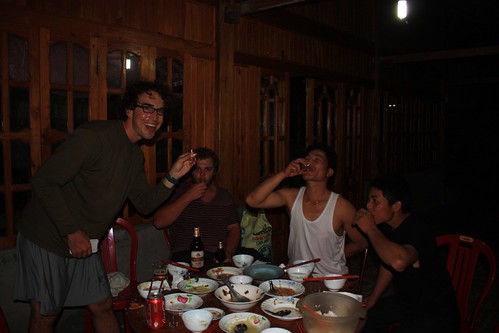
Sleep
The homestays in Sapa were like nothing we'd ever experienced. There were real toilets and hot showers, plus actual mattresses to sleep on! It was much more comfortable than our experience in Burma, and doing two nights of it was downright easy.
TIP: Trekking on your own? Just show up at the homestays and request to spend the night
They each have about 30 beds, so there's tons of room.
In Sapa town, we spent a night at the Sapa Grand View Hotel, which was the hotel that stored our bags while we were trekking. We bargained down to $15 for a mountain-view room that included breakfast. It was a good value and a decent room, though it got pretty cold at night.
Transport
Getting to Sapa by night bus or train is super easy and is included in any package you book. If you choose to do Sapa on your own, you'll still have to book the bus or train through a travel agent. The bus will cost you $15-18, and the train runs $40—one way! Stick to the bus, as the train requires you to switch to a bus at five in the morning, which doesn't really help with sleeping. You may get forced to pay an arm and a leg for that bus from the train station to Sapa, so for piece-of-mind, we recommend booking transport all the way to Sapa.
More Sapa
Interested in seeing the rice terraces of Sapa without paying for a plane ticket? Check out our Sapa photo tour.
Leave your tips for backpacking Sapa in the comments!
Comments